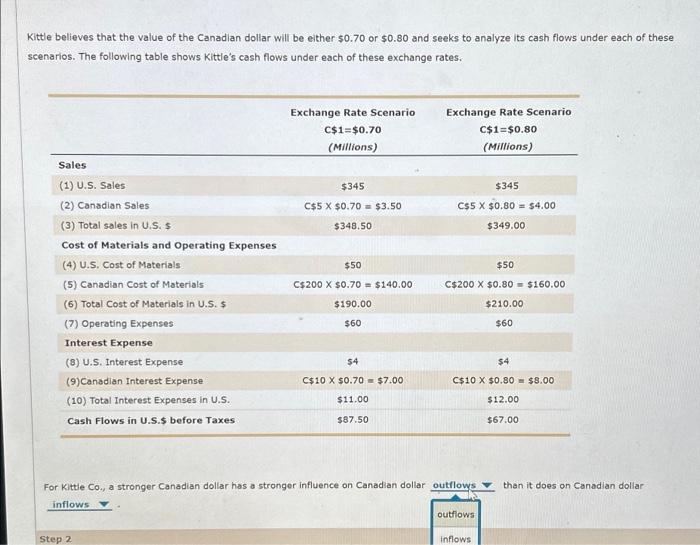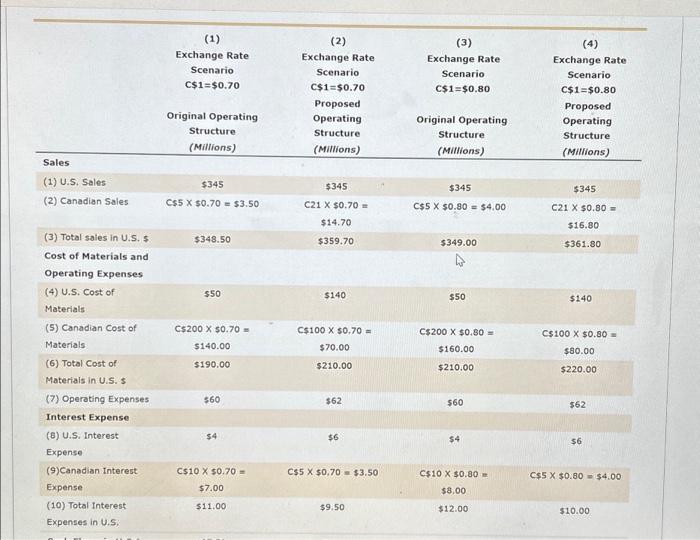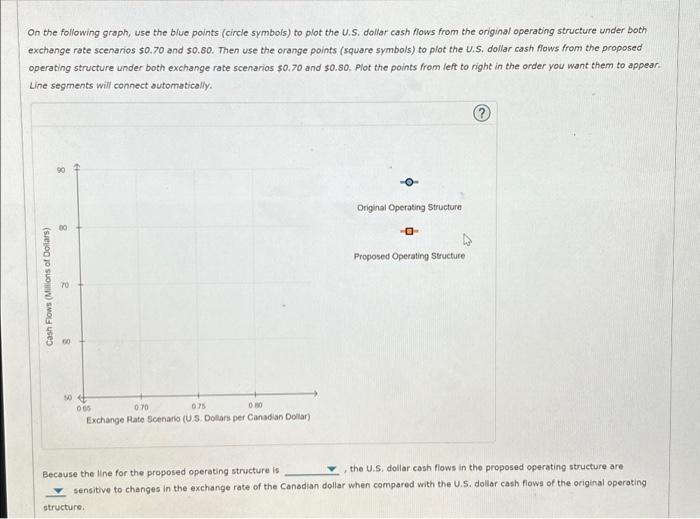Kittle estimates it's cash flows from both the U.S., in dollars, and Canada, in Canadian dollars, for a typlcal quarter. These figures are summarized In the following table. Kittle believes that the value of the Canadian dollar will be either $0.70 or $0.80 and seeks to analyze its cash flows under each of these scenarios. The following table shows Kittle's cash flows under each of these exchange rates. For Kittle Co, a stronger Canadian dollar has a stronger influence on Canadian dollar then it does on Canadian dollar In the previous stage, you saw that Kittie's operating structure, with low sales in Canada and high cost of materials from Canadian suppliers, was a source of significant economic exposure each quarter. Because of this, Kittle has decided to restructure it's operating structure. The largest part of the restructure involves an increase in U.S. operating expense in order to pay for efforts to increase Canadian sales, while also ordering more supplies from U.S. suppliers instead of Canadian suppliers. This restructuring also includes using more U.S. sources for financing instead of Canadian sources. The following table shows Kittle's cash flows under each of these exchange rates and operating structures. Columns (1) and (3) represent the original operating structures, while columns (2) and (4) represent the new, proposed operating structure. Use the table to answer the questions that follow. (1) (2) (3) (4) Exchange Rate Exchange Rate Exchange Rate Exchange Rate Cost of Materials and Operating Expenses (4) U.S. Cost of $50 $140 $50$140 Materials (5) Canadian Cost of Materials cs20050.70=$140.00$190.00c$10050.70=$70.00$210.00C$200$0.80=$160.00$210.00c$100$0.80=$80.00$220.00 (6) Total Cost of Materiais in U.5. 5 (7) Operating Expenses 560 $62 $60 $62 Interest Expense (8) U.S. Interest $4 $6 $4 $6 Expense (9)Canadian Interest Expenses in U.S. On the following graph, use the blue points (circle symbols) to plot the U.S. dollar cash flows from the original operating structure under both exchange rate scenarios 50.70 and 50.80. Then use the orange points (square symbols) to plot the U.S. dollar cash flows from the proposed operating structure under both exchange rate scenarios $0.70 and $0.80. Plot the points from left to right in the order you want them to appear. Line segments will connect outomatically. Because the line for the proposed operating structure is , the U.S. dollar cosh flows in the proposed operating structure are sensitive to changes in the exchange rate of the Canadian dollar when compared with the U.S. dollar cash flows of the original operating structure. Kittle estimates it's cash flows from both the U.S., in dollars, and Canada, in Canadian dollars, for a typlcal quarter. These figures are summarized In the following table. Kittle believes that the value of the Canadian dollar will be either $0.70 or $0.80 and seeks to analyze its cash flows under each of these scenarios. The following table shows Kittle's cash flows under each of these exchange rates. For Kittle Co, a stronger Canadian dollar has a stronger influence on Canadian dollar then it does on Canadian dollar In the previous stage, you saw that Kittie's operating structure, with low sales in Canada and high cost of materials from Canadian suppliers, was a source of significant economic exposure each quarter. Because of this, Kittle has decided to restructure it's operating structure. The largest part of the restructure involves an increase in U.S. operating expense in order to pay for efforts to increase Canadian sales, while also ordering more supplies from U.S. suppliers instead of Canadian suppliers. This restructuring also includes using more U.S. sources for financing instead of Canadian sources. The following table shows Kittle's cash flows under each of these exchange rates and operating structures. Columns (1) and (3) represent the original operating structures, while columns (2) and (4) represent the new, proposed operating structure. Use the table to answer the questions that follow. (1) (2) (3) (4) Exchange Rate Exchange Rate Exchange Rate Exchange Rate Cost of Materials and Operating Expenses (4) U.S. Cost of $50 $140 $50$140 Materials (5) Canadian Cost of Materials cs20050.70=$140.00$190.00c$10050.70=$70.00$210.00C$200$0.80=$160.00$210.00c$100$0.80=$80.00$220.00 (6) Total Cost of Materiais in U.5. 5 (7) Operating Expenses 560 $62 $60 $62 Interest Expense (8) U.S. Interest $4 $6 $4 $6 Expense (9)Canadian Interest Expenses in U.S. On the following graph, use the blue points (circle symbols) to plot the U.S. dollar cash flows from the original operating structure under both exchange rate scenarios 50.70 and 50.80. Then use the orange points (square symbols) to plot the U.S. dollar cash flows from the proposed operating structure under both exchange rate scenarios $0.70 and $0.80. Plot the points from left to right in the order you want them to appear. Line segments will connect outomatically. Because the line for the proposed operating structure is , the U.S. dollar cosh flows in the proposed operating structure are sensitive to changes in the exchange rate of the Canadian dollar when compared with the U.S. dollar cash flows of the original operating structure











